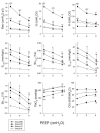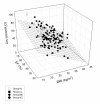Effects of respiratory mechanics on the capnogram phases: importance of dynamic compliance of the respiratory system
- PMID: 23031408
- PMCID: PMC3682277
- DOI: 10.1186/cc11659
Effects of respiratory mechanics on the capnogram phases: importance of dynamic compliance of the respiratory system
Abstract
Introduction: The slope of phase III of the capnogram (SIII) relates to progressive emptying of the alveoli, a ventilation/perfusion mismatch, and ventilation inhomogeneity. S(III) depends not only on the airway geometry, but also on the dynamic respiratory compliance (Crs); this latter effect has not been evaluated. Accordingly, we established the value of SIII for monitoring airway resistance during mechanical ventilation.
Methods: Sidestream capnography was performed during mechanical ventilation in patients undergoing elective cardiac surgery (n = 144). The airway resistance (Raw), total respiratory resistance and Crs displayed by the ventilator, the partial pressure of arterial oxygen (PaO2) and S(III) were measured in time domain (S(T-III)) and in a smaller cohort (n = 68) by volumetry (S(V-III)) with and without normalization to the average CO2 phase III concentration. Measurements were performed at positive end-expiratory pressure (PEEP) levels of 3, 6 and 9 cmH2O in patients with healthy lungs (Group HL), and in patients with respiratory symptoms involving low (Group LC), medium (Group MC) or high Crs (Group HC).
Results: S(T-III) and S(V-III) exhibited similar PEEP dependencies and distribution between the protocol groups formed on the basis of Crs. A wide interindividual scatter was observed in the overall Raw-S(T-III) relationship, which was primarily affected by Crs. Decreases in Raw with increasing PEEP were reflected in sharp falls in S(III) in Group HC, and in moderate decreases in S(III) in Group MC, whereas S(T-III) was insensitive to changes in airway caliber in Groups LC and HL.
Conclusions: SIII assessed in the time domain and by volumetry provide meaningful information about alterations in airway caliber, but only within an individual patient. Although S(T-III) may be of value for bedside monitoring of the airway properties, its sensitivity depends on Crs. Thus, assessment of the capnogram shape should always be coupled with Crs when the airway resistance or oxygenation are evaluated.
Figures




Similar articles
-
Capnogram slope and ventilation dead space parameters: comparison of mainstream and sidestream techniques.Br J Anaesth. 2016 Jul;117(1):109-17. doi: 10.1093/bja/aew127. Br J Anaesth. 2016. PMID: 27317710 Free PMC article.
-
A new application of an old method for respiratory mechanics measurements: the passive inflation method in newborn infants during pressure-controlled ventilation.Pediatr Pulmonol. 1994 Oct;18(4):244-54. doi: 10.1002/ppul.1950180409. Pediatr Pulmonol. 1994. PMID: 7838624 Clinical Trial.
-
The effects of positive end-expiratory pressure on respiratory system mechanics and hemodynamics in postoperative cardiac surgery patients.Braz J Med Biol Res. 2000 Jan;33(1):31-42. doi: 10.1590/s0100-879x2000000100005. Braz J Med Biol Res. 2000. PMID: 10625872 Clinical Trial.
-
Continuous estimation of respiratory system compliance and airway resistance during pressure-controlled ventilation without end-inspiration occlusion.BMC Pulm Med. 2024 May 20;24(1):249. doi: 10.1186/s12890-024-03061-2. BMC Pulm Med. 2024. PMID: 38769572 Free PMC article.
-
Clinical review: respiratory mechanics in spontaneous and assisted ventilation.Crit Care. 2005 Oct 5;9(5):472-84. doi: 10.1186/cc3516. Epub 2005 Apr 18. Crit Care. 2005. PMID: 16277736 Free PMC article. Review.
Cited by
-
Activation of Automatic Tube Compensation Mode Attenuates Auto-PEEP in Chronic Obstructive Pulmonary Disease Patients.Clin Respir J. 2024 Oct;18(10):e70028. doi: 10.1111/crj.70028. Clin Respir J. 2024. PMID: 39437807 Free PMC article.
-
Effects of thoracic squeezing on airway secretion removal in mechanically ventilated patients.Iran J Nurs Midwifery Res. 2016 May-Jun;21(3):337-42. doi: 10.4103/1735-9066.180374. Iran J Nurs Midwifery Res. 2016. PMID: 27186214 Free PMC article.
-
Methacholine-Induced Variations in Airway Volume and the Slope of the Alveolar Capnogram Are Distinctly Associated with Airflow Limitation and Airway Closure.PLoS One. 2015 Nov 23;10(11):e0143550. doi: 10.1371/journal.pone.0143550. eCollection 2015. PLoS One. 2015. PMID: 26599006 Free PMC article. Clinical Trial.
-
Capnogram slope and ventilation dead space parameters: comparison of mainstream and sidestream techniques.Br J Anaesth. 2016 Jul;117(1):109-17. doi: 10.1093/bja/aew127. Br J Anaesth. 2016. PMID: 27317710 Free PMC article.
-
Volumetric but Not Time Capnography Detects Ventilation/Perfusion Mismatch in Injured Rabbit Lung.Front Physiol. 2018 Dec 12;9:1805. doi: 10.3389/fphys.2018.01805. eCollection 2018. Front Physiol. 2018. PMID: 30618817 Free PMC article.
References
-
- Dubois AB, Britt AG, Fenn WO. Alveolar CO2 during the respiratory cycle. J Appl Physiol. 1952;16:535–548. - PubMed
-
- Crawford AB, Makowska M, Paiva M, Engel LA. Convection- and diffusion-dependent ventilation maldistribution in normal subjects. J Appl Physiol. 1985;16:838–846. - PubMed
-
- Dutrieue B, Vanholsbeeck F, Verbanck S, Paiva M. A human acinar structure for simulation of realistic alveolar plateau slopes. J Appl Physiol. 2000;16:1859–1867. - PubMed
Publication types
MeSH terms
LinkOut - more resources
Full Text Sources
Other Literature Sources

